Infrared thermometer is a device for smart people. Part 1
Temperature is the most important physical quantity for the measurement of which numerous methods have been devised. This article describes a non-contact method of measuring temperature using an MT4004 infrared thermometer.
On the one hand, the device is very simple to operate: point the thermometer at the object, press the button - you will get the result, and your dream will come true! So sang the group "Technology".
But why are you not happy?
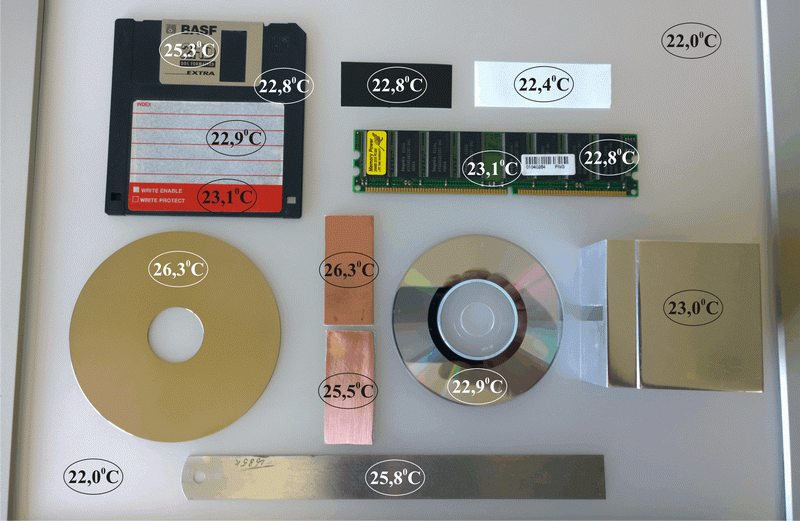
This is because the owner of the thermometer must have some knowledge in order to correctly determine (but even better - compare) the temperature and skillfully use the device. A thermometer will help reduce its costs and even save a life.
This knowledge, practical application and subtleties in working with an infrared thermometer are described in the article. It will not do without an exciting analysis of the device with the study of its insides.
Can I check the operation of the remote control using a thermometer?
It is believed that bees and butterflies find a flower by smell or color. And what about the “thermal” version?
How will a thermometer help reduce vehicle fuel consumption?
To blow or not to cool tea or soup (premium application)?
Why when feeding a child take porridge from the edge of the plate?
How to measure the average temperature in a hospital?
Does a pyrometer measure air temperature?
How to find the tube (cable) of the warm floor?
Why do we freeze in the wind?
Snakes, buttons and the paradox of the kettle
If you do not take into account various types of production in compliance with technological regimes, then the vast majority of people know for sure only a few temperature values: melting ice, the body of a healthy person, boiling water.
But even these familiar numbers 0, 36.6 and 100 have deviations. The body temperature in different places differs, the boiling point of water depends on atmospheric pressure, etc.
The temperature of everything else worries us at the “hot-cold” level and most importantly, so that it does not go beyond the usual framework.
A person can determine the temperature at a distance indirectly through the organs of hearing (hissing), smell (burned out) and vision (escaped).
But the main channel, it is 16,000 thermal receptors scattered throughout the body, so that it feels thermal radiation from the sun, a bonfire and a heating battery.
Rattlesnakes have two receptors that have a higher infrared sensitivity than humans, which allows them to hunt in complete darkness.
To expand his ability to remotely measure temperature, a man invented an infrared thermometer, one of which is the MT4004 model, which allows for quick measurement of surface temperature.
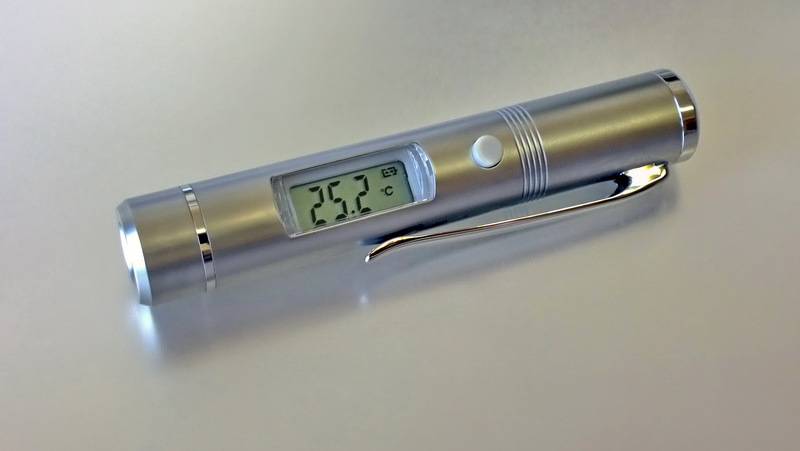
To take a measurement, press the “ON” power button located next to the indicator.
With a short press, the thermometer will measure and record the result for 15 seconds - until the device is turned off, which is convenient for determining the temperature in hard-to-reach places. Before turning off, the indicator shows the inscription “oFF”.
If the “ON” button is kept pressed, the thermometer switches to the continuous measurement mode with a frequency of two times per second. The selected speed makes it easy to read updated readings.
In general, the device has two buttons. The second is “C / F”, located on the back of the case and hidden in the bowels of the device. Access to it is through a hole in the body with a toothpick or a slightly pointed match. The button allows you to display the temperature in degrees Celsius or Fahrenheit. To switch the display mode, turn on the thermometer by briefly pressing the “ON” button, and then press the “C / F” button. In our country, degrees Fahrenheit are practically not used.
The operating range of the thermometer is -27.4 ... +428 degrees Fahrenheit (-33 ... +220 Celsius), so the movie “ 451 degrees Fahrenheit ” could not be shot. For paper arsonists, the instrument writes “Hi”, which means that the upper measurement limit is exceeded.
At the south pole, the device will write “Lo”.
In two tests, the inscription “Er2” was found - when the thermometer cut a stream of air with a temperature of 650 degrees Celsius and when it came too close to the gas comfort lamp. Perhaps it was an overheating sensor. It is logical that the inscription “Er1” must exist, but it did not seem to me (maybe it is for the better?).
A teapot is not only a characteristic of a novice specialist. This word also refers to a container for heating water.
Measure the temperature of a boiling kettle. Unfortunately, the jet of whistling steam is not observed in the photo, but it is (like the gopher that is not visible). From instrument readings and dependenciesboiling temperature from altitude one would think that measurements are taken at an altitude of 22.5 km. But in fact, everything happens much lower, since the operator is visible without a spacesuit.
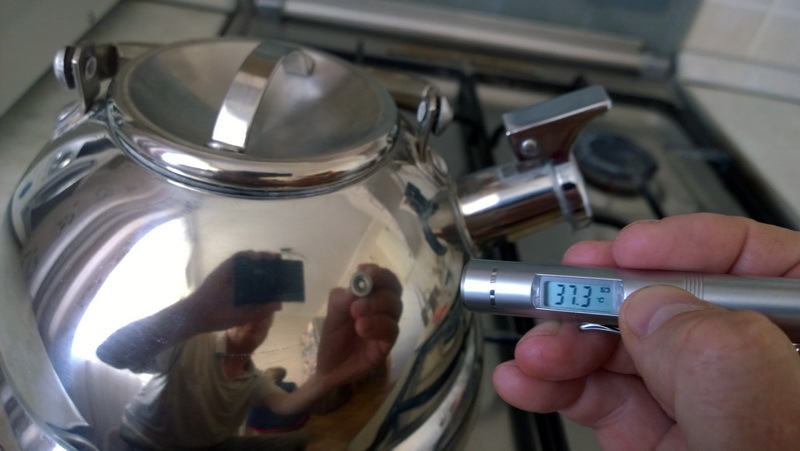
If you use the same kettle on trips, then, depending on the degree of its sootiness, when the water boils, the temperature of the case will increase to 95 ... 98 degrees.
What has changed except the soot that appears on the walls of the vessel?
The phenomenon, paradoxical at first glance, is explained simply. At the same temperature, different surfaces emit differently: some are stronger, others are weaker.
The study of infrared radiation and the complexity of its measurement
Radiation is radiation that can be ionizing, then dosimeters are used to measure it, which will be discussed later. In today's story, radiation refers to thermal (infrared) radiation, which is measured by a radiation pyrometer .
Although mankind used thermal radiation much earlier than its discovery in 1800, an intensive study of the infrared range of electromagnetic waves began from that moment thanks to the English astronomer William Herschel.
In the temperature range from absolute zero (not inclusive) to the Planck one , all bodies emit radiation in the infrared range of electromagnetic waves.
According to the law of Stefan - Boltzmann, the total bulk density of the equilibrium radiation and the total emissivity of a black body are proportional to the fourth degree of temperature.
So, by measuring the radiation power, you can determine the surface temperature.
But besides the fact that the sensitive element of the radiation thermometer does not work in the entire radiation range, there are a number of other but ...
1. The Stefan-Boltzmann law means the total amount of radiated energy. The energy distribution over the emission spectrum is described in the Planck formula formulated in 1900. Even at the same temperature, radiation consists of many radiation having different wavelengths, but there is a single maximum in the spectrum.
2. The position of the maximum in the spectrum depends on the temperature of the object and is determined by the Wien displacement law . Example: in the visible range, when the metal is heated, it turns red, and when the temperature rises, the radiation region “goes” to the high-frequency region, changing color to blue, which blacksmiths and thermists use in their work.
The expression "bring to white heat" means - very much warm up. And it is undesirable to do this with people.
It is important for us that with a change in the temperature of the object, the power of thermal radiation at the operating frequency of the sensor (receiver) of the thermometer changes, and this must be taken into account when measuring, especially for instruments with a wide measuring range.
3. According to the law of Kirchhoff radiation, the ratio of the emissivity of any body to its absorption capacity is the same for all bodies at a given temperature for a given frequency and does not depend on their shape and chemical nature.
Pay attention to the words “at a given temperature”. For different temperatures, this coefficient is different - even for one body.
The black body absorbs all the radiation incident on it, therefore, its emissivity is also equal to unity.
From the point of view of thermodynamics, all other real bodies are not black, but gray (even if for us they seem black or invisible) - they have the ability to absorb less than unity, and therefore their emissivity is also less than unity.
At the initial study of the thermal radiation of various materials, this fact was demonstrated in 1804 using a hollow Leslie cube filled with hot water , in which the vertical walls are covered with a layer of various materials: gold, silver, copper and soot. The side of the soot (close to the black body) has a radiation power much greater than the other three.
In the teapot, which was shown above, there is no gold and silver, but the essence of the processes is similar.
Peter van Mushenbruck (author of the first capacitor called “Leiden Bank”) in 1731 invented an optical pyrometer in which the temperature of an object was determined by color and brightness.
This review considers a radiation thermometer, which measures the power (intensity) of thermal radiation in one band of the radiation spectrum, on the basis of which the temperature value is calculated.
There are also spectral ratio (color) pyrometers with several receivers operating in different parts of the spectrum. Their principle of operation is based on the dependence of energy brightness on temperature in several areas of the spectrum at once.
The first portable pyrometer appeared in 1967. Since then, there has been an improvement in weight and size characteristics, measurement accuracy and capabilities.
The device and its analysis
40 grams - this is the result of weighing a thermometer, the overall dimensions of which 86.5x19.4x14.8 mm are comparable to my ring finger and only slightly exceed the size of an AA battery.

On the one hand, for such a baby, the mass is quite large, but the metal case, in addition to beauty, solidity and strength, has another important function - it allows the device to quickly set the ambient temperature, which improves the measurement accuracy.
The miniature size of the case allows measurements in places where access to other pyrometers is difficult or impossible.
In humans, a large mass is determined by good nutrition. And what does the infrared thermometer feed?
The power battery consists of two alkaline (manganese-zinc) cells of the LR44 type, analogues: L1154, A76, G13, (frame size 357) with a voltage of 1.5 volts and a capacity of 150 mA · h.
With silver-zinc elements such as V357, SR44, having an operating voltage of 1.55 volts and a capacity of up to 200 mA · h, the operation of the infrared thermometer was not tested.
As an experiment, ZA675 (PR44) air-zinc batteries with a voltage of 1.4 volts and a capacity of 650 mAh were tested! When checking the voltage, it was found that the just purchased element, suitable until July 2017, produces only 1.01 volts. The first thought was to return them to the seller, but the second came, which helped to find an interesting film. It is not explicitly said about low voltage, but after peeling off the protective film preventing the air from flowing in, the voltage began to increase and after a couple of minutes increased to 1.4 volts, which is the norm for this type of battery - an interesting fact, little known to the general public .
Elements are installed in the compartment, access to which opens after unscrewing the chrome cover.
Battery labeling and proper installation are shown in the picture inside the compartment.

On the inside of the cover is the serial number of the product. The license plate is not glued to the main part of the device, but its presence gives the product solidity.
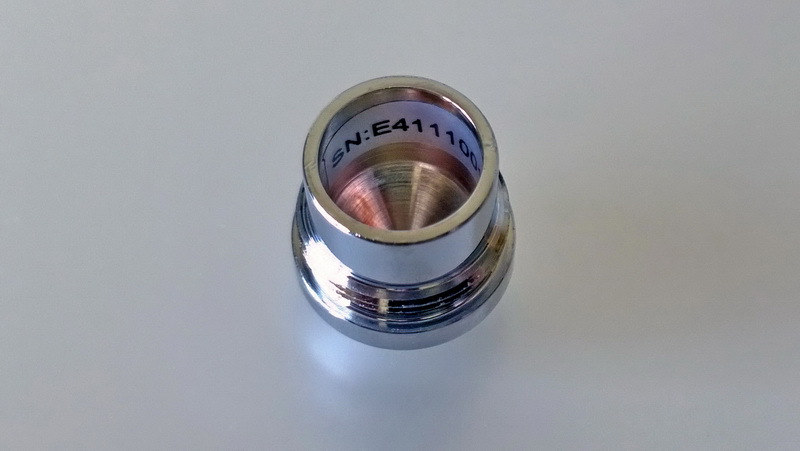
There is a “CE” mark on the device’s case, which confirms that the products comply with European safety standards for humans, property and the environment.
Studying the insides of the case leads to the idea that the device board can only be removed through the battery compartment.
An attempt to hook the plastic sleeve surrounding the battery with an L-shaped wire was unsuccessful. The reason is that the protective glass that covers the LCD indicator of the device is installed flush with the metal case and prevents the start of movement.
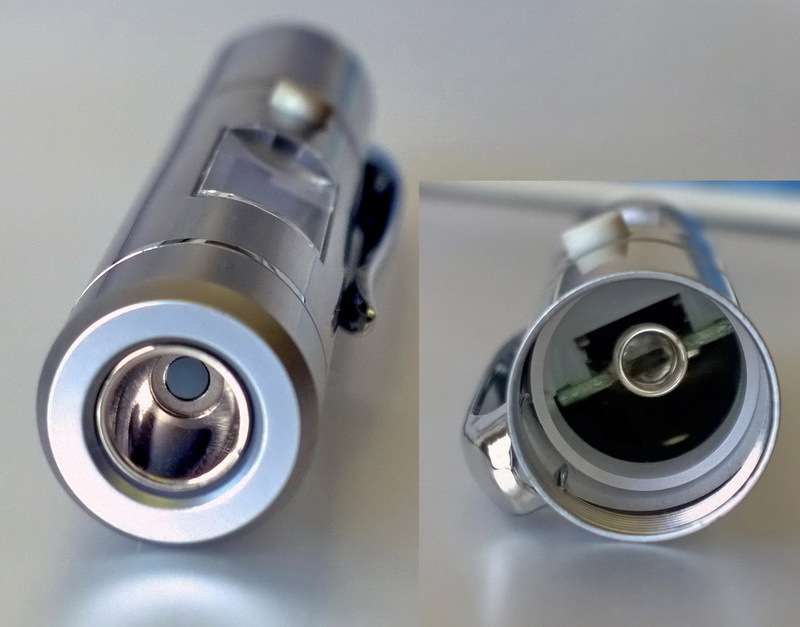
Side clamps are visible on this plastic “glass”, so the idea arose that for dismantling it was necessary to pull it up. The attempt was carried out using a thin clerical blade, then (when a gap appeared) an ordinary knife, and in the end a thin screwdriver was used.
The result of the operation: two blades of a clerical knife are damaged (it’s not a pity), one latch on the glass is broken (it’s a pity), scratches appeared on the glass (a lot of pity), the thermometer lost its presentation a little (sadly). That is why the analysis of the device is desirable to do at the end of all experiments with photographing.
After the screwdriver penetrated between the protective glass and the indicator, the opposite wall of the protective glass “fell” inside the metal case ... It became clear that the designer of this product used a solution that makes him admire (the designer).
Dismantling is not simple, but brilliantly simple! No adaptation is needed, the fixation is due to the springy properties of the plastic sleeve and the current collector, which lifts the protective glass into the cutout of the viewing window.
To disassemble the MT4004 thermometer, you must:
1. remove the batteries;
2. lower the rubber push rod of the button below the housing to facilitate subsequent ejection;
3. finger press on the protective glass of the indicator so that it falls below the case and push the inside of the device through the battery compartment.
After removing the plastic sleeve, we have the following picture, which also shows air-zinc batteries with openings for air intake, as well as a glass with a broken eye.
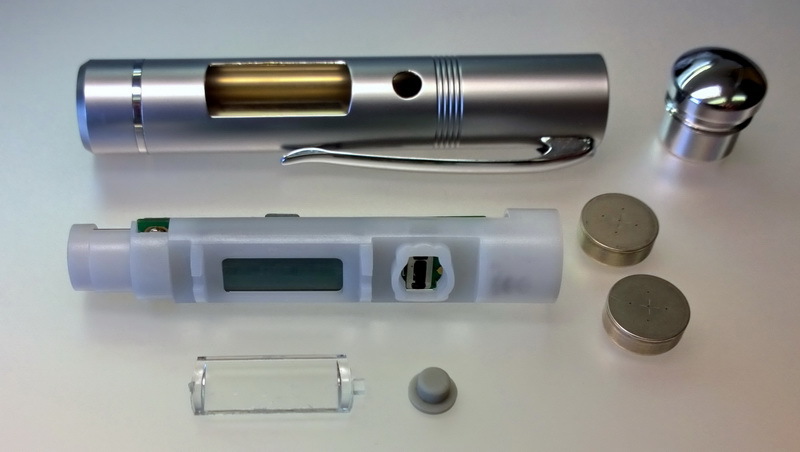
Reverse side of the sleeve.
The controller is made in a leadless design and is filled with a compound.
The board is varnished, paper is marked on the controller, as well as a marker on the board.
In addition to small things, from identifiable details there are:
93C46V1 - serial EEPROM chip with organization of 64 registers of 16 bits or 128 registers of 8 bits, the total capacity of 1,024 bits. Supply voltage from 1.8 to 5.5 volts. A program cannot fit in such a volume. Most likely, it contains constants for calibrating a specific sensor.
A rectangular capacitor of a relatively large size with the designation 104J63, which stands for 0.1 μfFh63V.
Power Button “ON”.
One screw is missing, as there is no space for fastening in the clip.

Judging by the appearance, an analog sensor similar to the TPS333 , operating in the range from 5 to 14 μm (µm) , is used as a sensitive element in the thermometer .
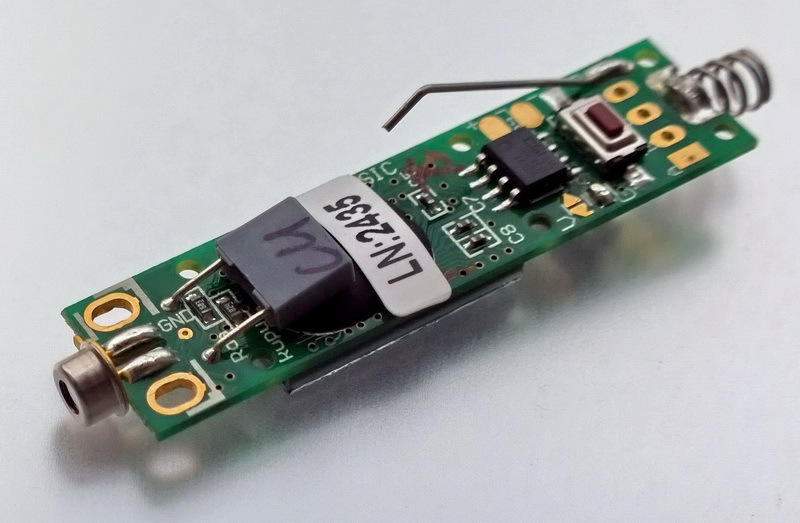
On the other side of the board are located: an LCD indicator, 32 768 Hz quartz and the “C / F” button (its body is higher than that of the “ON” button).
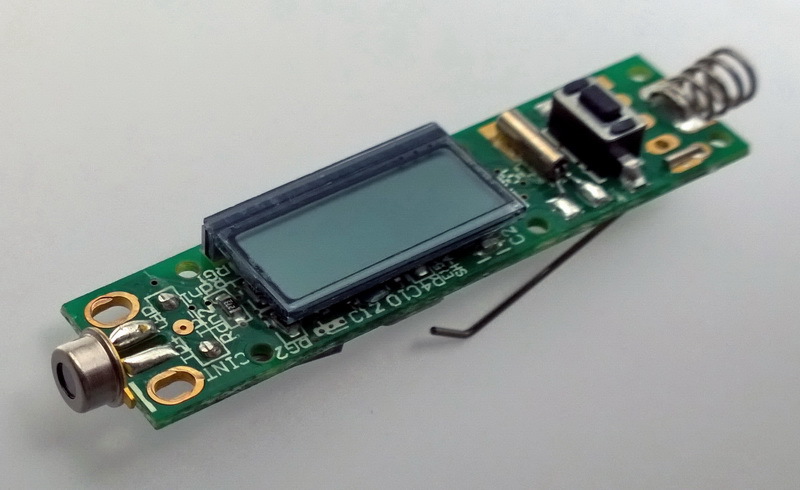
There are no complaints about the quality of soldering, assembly and installation, everything is done at a high level.
In the second part, interesting experiments are expected using this thermometer.
Photo album “ Infrared thermometer ” with numerous photographs, including those not included in the review of the infrared thermometer.
Link to the page where you can get acquainted with technical specifications, various methods of application and purchase an infrared thermometer MT4004.
Continuation of the article: "To blow or not to blow, and other experiments with an infrared thermometer ."
On the one hand, the device is very simple to operate: point the thermometer at the object, press the button - you will get the result, and your dream will come true! So sang the group "Technology".
But why are you not happy?

This is because the owner of the thermometer must have some knowledge in order to correctly determine (but even better - compare) the temperature and skillfully use the device. A thermometer will help reduce its costs and even save a life.
This knowledge, practical application and subtleties in working with an infrared thermometer are described in the article. It will not do without an exciting analysis of the device with the study of its insides.
Can I check the operation of the remote control using a thermometer?
It is believed that bees and butterflies find a flower by smell or color. And what about the “thermal” version?
How will a thermometer help reduce vehicle fuel consumption?
To blow or not to cool tea or soup (premium application)?
Why when feeding a child take porridge from the edge of the plate?
How to measure the average temperature in a hospital?
Does a pyrometer measure air temperature?
How to find the tube (cable) of the warm floor?
Why do we freeze in the wind?
Snakes, buttons and the paradox of the kettle
If you do not take into account various types of production in compliance with technological regimes, then the vast majority of people know for sure only a few temperature values: melting ice, the body of a healthy person, boiling water.
But even these familiar numbers 0, 36.6 and 100 have deviations. The body temperature in different places differs, the boiling point of water depends on atmospheric pressure, etc.
The temperature of everything else worries us at the “hot-cold” level and most importantly, so that it does not go beyond the usual framework.
A person can determine the temperature at a distance indirectly through the organs of hearing (hissing), smell (burned out) and vision (escaped).
But the main channel, it is 16,000 thermal receptors scattered throughout the body, so that it feels thermal radiation from the sun, a bonfire and a heating battery.
Rattlesnakes have two receptors that have a higher infrared sensitivity than humans, which allows them to hunt in complete darkness.
To expand his ability to remotely measure temperature, a man invented an infrared thermometer, one of which is the MT4004 model, which allows for quick measurement of surface temperature.

To take a measurement, press the “ON” power button located next to the indicator.
With a short press, the thermometer will measure and record the result for 15 seconds - until the device is turned off, which is convenient for determining the temperature in hard-to-reach places. Before turning off, the indicator shows the inscription “oFF”.
If the “ON” button is kept pressed, the thermometer switches to the continuous measurement mode with a frequency of two times per second. The selected speed makes it easy to read updated readings.
In general, the device has two buttons. The second is “C / F”, located on the back of the case and hidden in the bowels of the device. Access to it is through a hole in the body with a toothpick or a slightly pointed match. The button allows you to display the temperature in degrees Celsius or Fahrenheit. To switch the display mode, turn on the thermometer by briefly pressing the “ON” button, and then press the “C / F” button. In our country, degrees Fahrenheit are practically not used.
The operating range of the thermometer is -27.4 ... +428 degrees Fahrenheit (-33 ... +220 Celsius), so the movie “ 451 degrees Fahrenheit ” could not be shot. For paper arsonists, the instrument writes “Hi”, which means that the upper measurement limit is exceeded.
At the south pole, the device will write “Lo”.
In two tests, the inscription “Er2” was found - when the thermometer cut a stream of air with a temperature of 650 degrees Celsius and when it came too close to the gas comfort lamp. Perhaps it was an overheating sensor. It is logical that the inscription “Er1” must exist, but it did not seem to me (maybe it is for the better?).
A teapot is not only a characteristic of a novice specialist. This word also refers to a container for heating water.
Measure the temperature of a boiling kettle. Unfortunately, the jet of whistling steam is not observed in the photo, but it is (like the gopher that is not visible). From instrument readings and dependenciesboiling temperature from altitude one would think that measurements are taken at an altitude of 22.5 km. But in fact, everything happens much lower, since the operator is visible without a spacesuit.

If you use the same kettle on trips, then, depending on the degree of its sootiness, when the water boils, the temperature of the case will increase to 95 ... 98 degrees.
What has changed except the soot that appears on the walls of the vessel?
The phenomenon, paradoxical at first glance, is explained simply. At the same temperature, different surfaces emit differently: some are stronger, others are weaker.
The study of infrared radiation and the complexity of its measurement
Radiation is radiation that can be ionizing, then dosimeters are used to measure it, which will be discussed later. In today's story, radiation refers to thermal (infrared) radiation, which is measured by a radiation pyrometer .
Although mankind used thermal radiation much earlier than its discovery in 1800, an intensive study of the infrared range of electromagnetic waves began from that moment thanks to the English astronomer William Herschel.
In the temperature range from absolute zero (not inclusive) to the Planck one , all bodies emit radiation in the infrared range of electromagnetic waves.
According to the law of Stefan - Boltzmann, the total bulk density of the equilibrium radiation and the total emissivity of a black body are proportional to the fourth degree of temperature.
So, by measuring the radiation power, you can determine the surface temperature.
But besides the fact that the sensitive element of the radiation thermometer does not work in the entire radiation range, there are a number of other but ...
1. The Stefan-Boltzmann law means the total amount of radiated energy. The energy distribution over the emission spectrum is described in the Planck formula formulated in 1900. Even at the same temperature, radiation consists of many radiation having different wavelengths, but there is a single maximum in the spectrum.
2. The position of the maximum in the spectrum depends on the temperature of the object and is determined by the Wien displacement law . Example: in the visible range, when the metal is heated, it turns red, and when the temperature rises, the radiation region “goes” to the high-frequency region, changing color to blue, which blacksmiths and thermists use in their work.
The expression "bring to white heat" means - very much warm up. And it is undesirable to do this with people.
It is important for us that with a change in the temperature of the object, the power of thermal radiation at the operating frequency of the sensor (receiver) of the thermometer changes, and this must be taken into account when measuring, especially for instruments with a wide measuring range.
3. According to the law of Kirchhoff radiation, the ratio of the emissivity of any body to its absorption capacity is the same for all bodies at a given temperature for a given frequency and does not depend on their shape and chemical nature.
Pay attention to the words “at a given temperature”. For different temperatures, this coefficient is different - even for one body.
The black body absorbs all the radiation incident on it, therefore, its emissivity is also equal to unity.
From the point of view of thermodynamics, all other real bodies are not black, but gray (even if for us they seem black or invisible) - they have the ability to absorb less than unity, and therefore their emissivity is also less than unity.
At the initial study of the thermal radiation of various materials, this fact was demonstrated in 1804 using a hollow Leslie cube filled with hot water , in which the vertical walls are covered with a layer of various materials: gold, silver, copper and soot. The side of the soot (close to the black body) has a radiation power much greater than the other three.
In the teapot, which was shown above, there is no gold and silver, but the essence of the processes is similar.
Peter van Mushenbruck (author of the first capacitor called “Leiden Bank”) in 1731 invented an optical pyrometer in which the temperature of an object was determined by color and brightness.
This review considers a radiation thermometer, which measures the power (intensity) of thermal radiation in one band of the radiation spectrum, on the basis of which the temperature value is calculated.
There are also spectral ratio (color) pyrometers with several receivers operating in different parts of the spectrum. Their principle of operation is based on the dependence of energy brightness on temperature in several areas of the spectrum at once.
The first portable pyrometer appeared in 1967. Since then, there has been an improvement in weight and size characteristics, measurement accuracy and capabilities.
The device and its analysis
40 grams - this is the result of weighing a thermometer, the overall dimensions of which 86.5x19.4x14.8 mm are comparable to my ring finger and only slightly exceed the size of an AA battery.

On the one hand, for such a baby, the mass is quite large, but the metal case, in addition to beauty, solidity and strength, has another important function - it allows the device to quickly set the ambient temperature, which improves the measurement accuracy.
The miniature size of the case allows measurements in places where access to other pyrometers is difficult or impossible.
In humans, a large mass is determined by good nutrition. And what does the infrared thermometer feed?
The power battery consists of two alkaline (manganese-zinc) cells of the LR44 type, analogues: L1154, A76, G13, (frame size 357) with a voltage of 1.5 volts and a capacity of 150 mA · h.
With silver-zinc elements such as V357, SR44, having an operating voltage of 1.55 volts and a capacity of up to 200 mA · h, the operation of the infrared thermometer was not tested.
As an experiment, ZA675 (PR44) air-zinc batteries with a voltage of 1.4 volts and a capacity of 650 mAh were tested! When checking the voltage, it was found that the just purchased element, suitable until July 2017, produces only 1.01 volts. The first thought was to return them to the seller, but the second came, which helped to find an interesting film. It is not explicitly said about low voltage, but after peeling off the protective film preventing the air from flowing in, the voltage began to increase and after a couple of minutes increased to 1.4 volts, which is the norm for this type of battery - an interesting fact, little known to the general public .
Elements are installed in the compartment, access to which opens after unscrewing the chrome cover.
Battery labeling and proper installation are shown in the picture inside the compartment.

On the inside of the cover is the serial number of the product. The license plate is not glued to the main part of the device, but its presence gives the product solidity.

There is a “CE” mark on the device’s case, which confirms that the products comply with European safety standards for humans, property and the environment.
Studying the insides of the case leads to the idea that the device board can only be removed through the battery compartment.
An attempt to hook the plastic sleeve surrounding the battery with an L-shaped wire was unsuccessful. The reason is that the protective glass that covers the LCD indicator of the device is installed flush with the metal case and prevents the start of movement.

Side clamps are visible on this plastic “glass”, so the idea arose that for dismantling it was necessary to pull it up. The attempt was carried out using a thin clerical blade, then (when a gap appeared) an ordinary knife, and in the end a thin screwdriver was used.
The result of the operation: two blades of a clerical knife are damaged (it’s not a pity), one latch on the glass is broken (it’s a pity), scratches appeared on the glass (a lot of pity), the thermometer lost its presentation a little (sadly). That is why the analysis of the device is desirable to do at the end of all experiments with photographing.
After the screwdriver penetrated between the protective glass and the indicator, the opposite wall of the protective glass “fell” inside the metal case ... It became clear that the designer of this product used a solution that makes him admire (the designer).
Dismantling is not simple, but brilliantly simple! No adaptation is needed, the fixation is due to the springy properties of the plastic sleeve and the current collector, which lifts the protective glass into the cutout of the viewing window.
To disassemble the MT4004 thermometer, you must:
1. remove the batteries;
2. lower the rubber push rod of the button below the housing to facilitate subsequent ejection;
3. finger press on the protective glass of the indicator so that it falls below the case and push the inside of the device through the battery compartment.
After removing the plastic sleeve, we have the following picture, which also shows air-zinc batteries with openings for air intake, as well as a glass with a broken eye.

Reverse side of the sleeve.
The controller is made in a leadless design and is filled with a compound.
The board is varnished, paper is marked on the controller, as well as a marker on the board.
In addition to small things, from identifiable details there are:
93C46V1 - serial EEPROM chip with organization of 64 registers of 16 bits or 128 registers of 8 bits, the total capacity of 1,024 bits. Supply voltage from 1.8 to 5.5 volts. A program cannot fit in such a volume. Most likely, it contains constants for calibrating a specific sensor.
A rectangular capacitor of a relatively large size with the designation 104J63, which stands for 0.1 μfFh63V.
Power Button “ON”.
One screw is missing, as there is no space for fastening in the clip.

Judging by the appearance, an analog sensor similar to the TPS333 , operating in the range from 5 to 14 μm (µm) , is used as a sensitive element in the thermometer .

On the other side of the board are located: an LCD indicator, 32 768 Hz quartz and the “C / F” button (its body is higher than that of the “ON” button).

There are no complaints about the quality of soldering, assembly and installation, everything is done at a high level.
In the second part, interesting experiments are expected using this thermometer.
Photo album “ Infrared thermometer ” with numerous photographs, including those not included in the review of the infrared thermometer.
Link to the page where you can get acquainted with technical specifications, various methods of application and purchase an infrared thermometer MT4004.
Continuation of the article: "To blow or not to blow, and other experiments with an infrared thermometer ."
